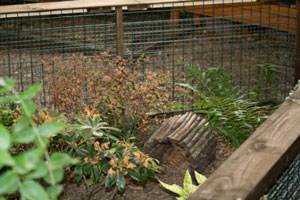SETTING THEM FREE
Short stay animals - a week or less

in spring, summer, or autumn should be released at dusk or after dark.
Damp conditions are good but hard ground (either from frost in early spring or drought in summer) makes finding food difficult for them.
Try to put them back as near to where they were found as is safe and sensible.
They do know their own home area and so it is usually only those found in a precarious place such as a building site that will need be taken to another, safer, location but there are checks that MUST be done first to make sure the area is suitable or you may be condemning them to a lonely death.
ALL releases no matter how long they have been in captivity
Wherever you take them, you must make sure there are other Hedgehogs in the area. If there aren't any there will be a very good reason why not. Try to make sure there are no Badgers around as although they don't routinely kill hedgehogs for food, they will if there is no other food available and are pretty much the only predators that have no problem with spines.
If you intend to release in a garden, make sure there is free access in and out. Hogs travel large distances and the recommended minimum area for them is 10 good sized gardens. You cannot keep a healthy hog locked in your own garden to act as slug control. If you want it to stay around, even though it can leave at any time, put out food and water for it every day.
Long stay animals - a couple of weeks or overwintered
You should only release overwintered animals when the ground is not frozen which typically means overnight temperatures have been above 0°c for at least a week. We have found most success at 5°c and above for at least a week ahead.
If the weather is forecast to take a bad turn again, then keep the hogs in or put them outside in a pre-release pen with a house, food and water available at all times to acclimatise ready for release.

All long stay hedgehogs, especially those brought in as babies or very young juveniles, will ideally need to spend some time in an outside pen or hutch before release to get acclimatised. To make the transition back to the wild as gentle as possible, this may only be for a couple of days. Once released, we would like you to put out some food and water at least for the first few nights but preferably permanently. To stop cats or birds getting the food, you can put it under an upside-down box with a hole cut out of the side, under a slab resting on 4 bricks on edge or in a purpose built feeding station with a tunnel similar to a house. DO NOT put food in a hedgehog house as you will not get a permanent resident.
If the hedgehog disappears on the first night and does not touch the food, then continue to leave some out for it as it may well return to base once it knows the area. A bowl of water on the ground at all times, but especially in dry weather is very welcome for all wildlife, and of course if you have gained a regular garden visitor, it would be nice to continue providing extra food for him.
The hedgehog should be released in a house or sack of hay, not straw, which should be put in a sheltered place, under a hedge or bush or by your shed. It will come out in its own time (once you have stopped watching) and go on its way!
If you have an enclosed or walled garden please DON'T put the hedgehog inside. It is very cruel to keep a healthy hedgehog in one garden. They need to wander about one mile per night, especially in the mating season.
Hedgehogs should never be released into the wild in autumn unless they weigh more than 1 lb (450gms).
From the end of October onwards the weight needs to be 600g absolute minimum, and preferably 700g+, to cope with the shortened feeding time available prior to hibernation.
Releasing captive hedgehogs into the wild
The Wildlife Aid Foundation have provided the following information.
- Do the hedgehogs fail to find adequate food in unfamiliar surroundings, having been used to getting it from a dish?
- No: they lose weight initially but after a few days regain it and thereafter maintain a normal body weight.
- Do they tend to ‘home’ towards the place where they had formerly lived?
- No: they quickly become accustomed to their new surroundings and soon are travelling similar distances at night to the wild hedgehogs that live in the same area. (However, a couple of animals in one of the studies carried out by Dr Pat Morris failed to adapt and just stayed in their nest for days).
- If they build a nest can they find their way back to it over unfamiliar ground?
- Yes: they continue to use the same nest or move to another, just as wild hedgehogs do. There is probably little point in trying to build a nest yourself for the animal to use. Hedgehogs are better at nest building than we are and the chances are that they will locate a better place to live than the one provided. You could still try though – there may be a shortage of nest sites in the locality. Perhaps better still, leave a small bundle of dry leaves or hay near to your hedgehog's release point.
- If they find a garden with supplementary food put out for hedgehogs will they stay there and become dependent upon un-natural food as in their captive life?
- No: probably not. Wild hedgehogs use plates of food as a supplement to their natural food, not a replacement for it.
- Should food be put out at the release site?
- Can't do any harm, but it is not essential, especially if you have managed to adjust your hedgehog's diet to include natural food. In very dry weather water should always be left near the release site. For hedgehogs released in the garden the best thing would be to leave their cage or pen, with food in it, and have the door open so that the hedgehogs could return to feed or use their old nest box if they wished.
- What is the best time of year to let them go?
- In winter choose mild muggy weather if possible; avoid periods of snow and especially severe frost. In summer, any time, but warm, moist weather is best; rainy weather is better than dry because there are likely to be more worms and similar food easily available than in dry periods. Aim to release your hedgehog at dusk as this is when they would normally awaken from daytime sleep in the wild. This will then give your newly released hedgehog the benefit of the cover of darkness to root around and become acquainted with his/her new home.
- Where is the best place to let them go?
- Research your site carefully. Choose places where there are likely to be hedgehogs already (no evidence that wild ones will ostracise the released animals). Parks, recreation grounds with nearby gardens, big cemeteries, lush pastureland, moist deciduous woodland are good places. Conifer woods, moorland, arable farmland, open bracken covered hillsides are bad sites, also if possible avoid areas where there are badgers.
Do NOT pick a place that is likely to be waterlogged in winter, even if it looks suitable in summer, unless there are nearby areas of well drained land adequate for winter nesting. Also bear in mind that slug pellets and pesticides can prove fatal to hedgehogs. Hedges, thickets, brambles and dense cover are needed for siting winter nests; plentiful fallen leaves are essential for nest construction. Straw, grass, and dried bracken are suitable nesting materials in captivity (so is newspaper), but not very good in the wild being insufficiently weatherproof. - How far do I need to take the hedgehogs from a road to be sure they won't get run over?
- Hedgehogs regularly travel upwards of a mile a night and it is difficult to find anywhere in lowland Britain more than a mile from a road. Country roads are just as dangerous as well lit busy town ones. Once the animal has been released it will have to take its chance, just as wild ones do. Dangers can be lessened; small roads with little traffic and suburban roads with slow traffic may be less hazardous; also ensure that release is into a large habitat area (e.g. several acres) so that there is less need for the animal to leave it and seek more space and opportunities elsewhere.
Do not take hedgehogs to islands (or other isolated places) with the idea of stocking up a new habitat or giving them a place to themselves. This may be illegal and may also be cruel if the site turns out to be insufficiently big or rich enough in food. Very little research has been done on this sort of thing and so we don't know what is too small an area; in any case it will depend upon habitat type. But we do know that it is possible that taking hedgehogs to an island could upset the fragile balance of other forms of wildlife.







